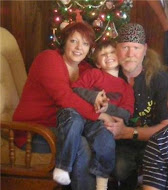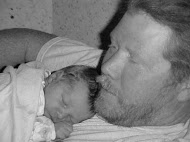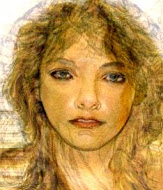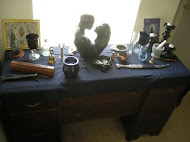Are you a witch?
Are you a fairy?
Are you the wife of Michael Cleary?
The Irish nursery rhyme memorializes Bridget Cleary ( February 1867 - March 1895), often described as the last witch burned in Ireland, and popularly known as the fairy witch of Tipperary. Although Ireland had among the mildest witchcraft persecutions in Europe, it is often credited with hosting the first and last witch burnings of Europe. Books sometimes chart the entire witchcraze from Pertonilla of Meath, as the first woman officially burned as a witch, to Bridget who died at the tail end of the nineteenth century, aged 28. In neither case is the parallel exactly accurate: women were burned as witches prior to Petronilla and continue to be burned today, although now in different parts of the globe, Furthermore, Bridget Cleary's death was not typical of a victim of the witchcraze.
Witchcraft was a crime during the Burning Times. Whether or not individuals were indeed practitioners of any sort, they were officially charged with crimes, tried according to an official process, convicted, and condemned to capital punishment, Their deaths, however horrific, were legal. No one was charged and punished for these deaths,
Those convicted as witches were considered the guilty parties.
Bridget Cleary, on the other hand, was killed by her husband in the process of what he described as an exorcism: he allegedly believed that she was a changeling and was attempting to get his wife back. Michael Cleary was subsequently arrested and charged with the murder of Bridget Cleary, He was convicted and served a prison sentence.
It is probable that what happened to Bridget Cleary was not unique: what was unique - and remains so in much of the world - is that someone was held responsible and punished for causing the death of a woman many believed to be a witch. Her story pulls the blankets off the suppressed subject of the Fairy Faith -both it's genuine practitioners and those intensely opposed to it. Her story is also very revealing regarding the perceived blending or interchangeableness of witches and fairies, The ordeal that she underwent at the hands of her husband, neighbors, and family is certainly reminiscent of witch-trial ordeals.
Her maiden name was Bridget Boland. She attended school, off and on. until she was 14. At the age of 20 she married Michael Cleary, a cooper, on August 5, 1887, He moved into the house Bridget shared with her parents. The two couples lived together in that house until the death of Bridget's mother, one year before her own death. Bridget's mother, Bridget Keating Boland died on February 1, 1894, leaving Bridget Jr, alone in the house with the two men who would both be implicated in the death.
According to her father's court testimony. Michael Cleary asked him "Don't you know it's with an old witch I am sleeping?" Whether this meant Michael believed her to be a changeling or whether this meant he opposed her forays into the Fairy Faith is subject to interpretation.
Both Bridget's and Michael Cleary's mothers were reportedly fairy doctors. It is possible that Bridget was training to become one as well. She had a strong independent streak, noticed and resented by some, She had a reputation of being haughty, proud, and "fine" and was disliked by some of her peers - young women who mostly lived a very different existence from Bridget. She was independent and enterprising: she owned a Singer sewing machine and kept chickens; thus Bridget, unlike most other women in her community, had an independent income. Keeping poultry was among the very few ways to evade complete male control of the purse strings: she sold eggs and also took in sewing.
Also unique among her female contemporaries, after eight years of marriage Bridget was childless and rather than seeming to mourn this, she seemed to relish her freedom. With no children, Bridget could come and go as she pleased and she did. She sewed and sold eggs, earning her own money, giving her a measure of economic independence.
In the wake of the scandal following her death, Bridget's neighbors and family were interviewed about her. According to reports, she had a defiant streak and wasn't easily cowed by authority. Joan Hoff and Marian Yeates, authors of The Cooper's Wife is Missing, describe Bridget as possessing what neighbors perceived as a "disturbing habit" of looking men in the eyes a trait allegedly characteristic of Pagan women.
Bridget's mother had a reputation as a "fairy expert" and bore something of a reputation as a witch, Perhaps Bridget inherited her interest in the Fairy Faith from her mother. Certainly she displayed a fascination with fairies and, especially in the last year of her life, following the death of her mother was often observed visiting two local fairy forts, leading to gossip by neighbors who speculated as to her motivation for the visits. Among the reasons suggested:
- She was trying to make contact with the soul of her dead mother
- She was rendezvousing with a lover
- She was irresistibly lured there by the fairies
Michael Cleary had his own personal history with the fairies: as a boy, his mother (also named Bridget) had allegedly run off with the fairies, disappearing for three days, Following her return, she allegedly began operating as a fairy doctor, Michael had strong feelings about fairies, too: he feared and hated them, and was obsessed with the notion that they would abduct Bridget - or that she would willingly join them.
The first known indication of dissension between Michael and Bridget occurred around Yuletide 1894. Michael allegedly feared she'd been abducted by fairies, and he ordered Bridget not to go to the fairy forts. She defied him and continued to go. (After her death, witnesses came forward saying that Michael had threatened to burn her if she went back.) She was observed visiting a fairy fort on February 1, 1895, the first anniversary of her mother's death.
On March 6, 1895, Bridget returned home in the late afternoon, ostensibly from delivering eggs, complaining of feeling unwell. (Witnesses suggested that she had been observed at the fairy fort that day.) She exhibited signs of fairy-related illness: aches. pains, and chills. She was irritable, described as "distant" and demonstrated some memory loss. Changes in temperament and appearance are among symptoms of fairy abduction, (In other words, a fairy is believed to have replaced or be impersonating the person believed to have been abducted.)
Initially, the family requested conventional medical attention. A local physician was requested to pay a house call. It took the doctor four days to respond following repeated requests. He examined Bridget, and determined nervous exhaustion and slight bronchitis. Despite requests for the doctor's arrival, Michael allegedly suspected that his wife had been abducted by fairies, who had replaced her with a changeling. Michael perceived that Bridget was now two inches taller than previously and that she seemed, in his words, "more refined."
For nine days, Bridget lay ill with a mysterious ailment, During these nine days, assorted friends, neighbors, and relatives came in and out. Her husband, convinced that his wife had been abducted by the fairies, searched for help from two sources - the Church and fairy experts. He was heard arguing with Bridget who was allegedly heard to cry out "If I had my mother, I would not be this way."
Nine was a magic number; one theory allegedly subscribed to by Michael, suggest that if the return of the abducted person is not affected within nine days, they are lost forever, although this contradicts the many tales pf changelings returning after seven years in Fairyland.
On at least three occasions requests were made for a priest's assistance. Priests were traditionally called in to exorcise fairies, considered akin to demons. This is "folk Catholicism" and was not standard practice even then. Theoretically it was not permitted, although allegedly it was common practice. A priest met with Bridget twice, Father Ryan spoke to Bridget for over 20 minutes, later describing her as coherent and intelligent. He said he thought her behavior might indicate the onset of "brain fever" and so decided to administer the last rites, just in case...She allegedly did not swallow the communion wafer: one witness claimed that she spat it out surreptitiously. this further confirming suspicions that Bridget Cleary had been abducted and that what lay in her place was a changeling.
Shortly afterwards, with the participation pf other neighbors and family members including her father and cousins, Bridget Cleary was killed by her husband and another relative, John Dunne, a local "fairy expert." Dunne was not a fairy doctor in the traditional sense. Two types of "fairy experts" existed:
- Fairy doctors, practitioners of the Fairy Faith, who were enthralled by fairies trained by them, and practiced arts associated with them
- What are essentially fairy exorcists, whose techniques drew heavily on Roman Catholic rites of exorcism and witchcraft trial ordeals; fairies were believed by these practitioners to be akin to demons; those allied with them were akin to witches.
Bridget was prescribed an herbal formula created from bitter herbs called "Seven Sisters Kill or Cure." It did neither. Michael then purchased an herbal cure called "Nine in One Cure," more potent and more exceedingly bitter than the Seven Sisters mixture. In these nine days, Bridget had not been permitted to leave her home, she was in a weakened condition from her mysterious illness and perhaps from lack of nourishment: attempts were made to starve out the changeling, She was apparently afraid for her safety and requested that the police be called. This was not done.
Witnesses described the final ordeal of Bridget. A sixteen year old neighbor stood in the corner of the room holding a candle for illumination. John Dunne sat on the bed gripping Bridget's hair. Two other men held her body down, each pinning down one shoulder, while another man pinned down her feet. Michael attempted to force Bridget to swallow the Nine in One herbal cure in new milk, yelling at her to "Swallow it, you devil!" and "Take it, you old witch!" Her mouth was pried open: Bridget fought back, only confirming the belief that she was fairy-possessed. It ultimately took six men to pour the liquid down her throat.
After Bridget was forced to swallow the Nine in One Cure, the family waited three hours for a "change." When none was forthcoming, the "exorcism" escalated and the threat of fire was introduced. At midnight on March 15th, Bridget was dressed in her finest clothes including a red petticoat in order that she could "go amongst the people" - however one interprets this. ("The People" is a euphemism for fairies.)
Urine was then thrown over her. She was choked, force-fed urine and herbs and pushed to the ground, her head knocking against the floor. Her clothes were stripped off, Bridget was shoved over the grate into the four-foot by four-foot fireplace, like some fairy-tale character (the witch in Hansel and Gretel for instance) in a fetal position with her legs sticking out. According to a witness there was a low fire burning in the fireplace, hot enough to heat an iron grill but not hot enough to boil water, She was threatened with a hot iron poker. ( Fairies allegedly fear both iron and fire so the combination was perceived as doubly powerful.)
Michael Cleary poured the contents of a can of paraffin oil over his wife and set her on fire. A witness claimed that the two women present attempted to put out the fire but Michael pushed them away, threatening to "roast" them as well. He proceeded to pour more oil over her burning body. According to a witness, Michael Cleary said he wasn't burning his wife; he was burning a witch who would go up the chimney.
Another witness, (Protestant neighbor Minnie Simpson) later asserted to the police that the family members believed that the person was not Bridget but a witch, although she claimed that she herself (Minnie) did not. She did not explain, however, why in that case she didn't help Bridget, nor did she point out that she was among those who supplied the urine thrown on Bridget.
At this point, people allegedly thought Bridget was "cured" and left. Michael asserted that he wasn't sure and wished to remain with Bridget for further observation, promising to meet up with family members later at his father's house, although he apparently never arrived,
Based on the testimony of witnesses, Bridget was still alive when they left, It is unclear exactly when she died, however her dead body was discovered on March 22, 1895, 1,300 yards from the Cleary home, wrapped in a sheet and buried in a shallow grave. Her entire back and lower abdomen had been burned; roasted clear to the bone, her internal organs visible. Her right hand was severely burned but her face, hair. breasts, shoulders, neck, legs, and feet remained unscathed, There were marks about her face and mouth and bruises on her neck, believed to be the result of choking, Death was caused by extensive burns, with the official cause given as "shock due to burns."
Eleven people were arrested in connection with the murder of Bridget Cleary, including the 16-year-old neighbor who stood quietly in the corner, holding the candle. There are two ways to understand the saga of Bridget Cleary:
- There is no possession, there's no such thing, therefore it's deadly superstition or an excuse for fatal spousal abuse. ( And local gossip alleged that Bridget had a lover.)
- Regardless of whether Bridget was or was not possessed her husband and family feared rather than understood fairies, The Fairy Faith was not charming to them. Fairies were considered devils to be exorcized; the "changeling" was considered a witch to be burned as were perhaps practitioners of the old Fairy Faith.
Bridget Cleary's mother was locally rumored to be a witch, If one believes that Bridget was attempting to follow in her late mother's and mother-in-law's footsteps and become a traditional fairy doctor herself, perhaps she was burned as a witch to prevent achievement of her goals. The methods of exorcism to which her family resorted were not typical of the Fairy Faith, whose practitioners openly derived their skills from fairies, Instead the herbal cures and rituals were heavily influenced by the Roman Catholic rites of exorcism and also by published accounts of witch-trial ordeals. Trial testimony indicated that invocation of the names of the Father, Son and Holy Ghost formed a significant part of the exorcism ritual.
Although Michael Cleary was mocked for believing in fairies, his actions were not those of a practitioner of the Fairy Faith but were grounded in folk Catholicism, Bridget's screams were ignored because they were considered the screams of the invading spirit (fairy and/or demon). Lying in bed, Bridget told a visiting cousin that her husband was "making a fairy of me now" and that "He thought to burn me about three months ago." How to interpret these statements? Did Michael Cleary genuinely believe she was a fairy, or beneath the mask was this just a case of spousal abuse, or both? Was the goal to break the fairies' charm or to break the spirit of an independent woman?
The crime was a major public scandal; the "fairy murder" was popular with the media and drew international attention, much to the displeasure of the local authorities who felt it made the region appear primitive and ignorant. Although Michael Cleary and Bridget's family were arrested for her murder, there was ambivalence toward Bridget as well. She had not been generally beloved; whether "abducted" or not, she had clearly been dabbling with fairies. Attitudes toward Bridget may be demonstrated by her funeral, or lack thereof: In a macabre denouement, Bridget's body could not be released to her family, all of whom had been arrested and were confined on Clonmel Goal, Police called for the clergy but no priests in the district responded: Roman Catholic priests were strictly charged against performing sacraments where fairy-craft was suspected. Those who died under suspicion were refused Church burial.
The body of Bridget Cleary was finally buried at night by four policemen who read part of the burial service over her body. They obtained a simple coffin for Bridget and brought her to the Roman Catholic cemetery at Cloneen. where she was buried outside the church walls beside the unmarked grave of her mother near an oak tree. Bridget Cleary and her mother lie together in unmarked graves outside the church walls. No headstones exist but two stones mark the site.
During the trial, absolutely no discussion of fairies, or even any reference to them, was permitted. Michael Cleary was found guilty of manslaughter, not murder, and sentenced to 20 years imprisonment, of which he served 15. Other defendants received lesser sentences depending upon perceived involvement.
Further Reading:
Information obtained in entirety from The Element Encyclopedia of Witchcraft















No comments:
Post a Comment